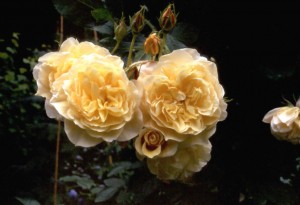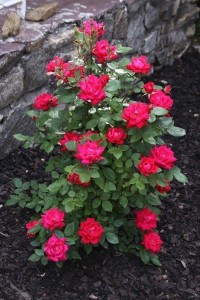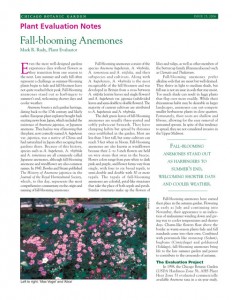
With many new nursery catalogs arriving in my mailbox at work for 2016 introductions, I thought I would focus this blog on “new” plants. With all the publicity and marketing that goes on for new plant introductions, you would think that they are the next best thing since draft beer or even bread! I am a bit cynical and question whether these new plants really live up to their performance expectations and ornamental attributes. With so many new hydrangeas, coneflowers, coralbells, spireas, etc. released each year, you may ask why am I so cynical? Why would I not jump on the bandwagon and promote all of these new plants like so many garden centers are doing across America? Let me explain.
A decade ago, I conducted research trials evaluating 20 new or recently introduced cultivars of “hardy” shrub roses, many of which are not even on the market anymore. I chose three locations in the state of Wisconsin, each having their own unique soil types, pH, soil drainage and fertility, rain/snowfall and cold hardiness zones. I replicated each of the 20 cultivars ten times at each location and arranged them into blocks with each cultivar represented in each of the ten blocks. The roses were randomly selected for each block and planted, mulched, watered with an application of a slow-release fertilizer. Plants were watered for the first year only as needed. To properly analyze plants for various traits, I allowed the roses to establish for a year with evaluation initiated the following spring. The only care the roses received the remaining years were application of a slow-release fertilizer, weeding and pruning of dead wood following winter. I was trying to replicate conditions that are common in most landscape settings. I did not spray any insecticides or fungicides to any of the roses, regardless of how bad they may have looked due to pests.
After the first winter, I evaluated the roses for winter injury, which they all experienced. The roses were all on their own root systems so if they died back significantly, the new growth would come from the same root system and produce flowers that spring. To some extent, they all grew, though voles killed some of the roses. After the roses starting growing, I evaluated them monthly at all three locations for insects and diseases as well as flowering (amount, size, duration of bloom, etc.). I also measured the plant’s height and spread. A few roses had good fall color. The first year of the trial, the roses all bloomed prolifically. So, one would think that all 20 cultivars are ideal. Not so fast, or “but wait, there’s more” as the television salesman would say to viewers in TV land about a new product. The “real” evaluation started in year two.
In year two, amount of dieback and winter survivability was recorded. To my surprise, the roses in the zone 3 location (boy, that’s cold) had better winter survival than the roses in my zone 4 and 5 location! This is due to consistent and significant snowfall in the most northern location compared to sporadic snowfall and lower amounts in the other two locations. I also evaluated the roses during the summer and fall for flowering, pests, and hip production. Contrary to the catalogs, many of the roses had hips, but some of them never colored up before the cold temperatures arrived at the three locations. Flower production was cited as being continuous all summer by their introducers, however, this was not true for some of the cultivars evaluated. Disease resistance was the most alarming quality I evaluated with many of the so-called “disease resistant” roses being the exact opposite. I explain all these variables to demonstrate what is involved in proper plant evaluation. For a complete report of my rose research trial, see: Jull, L.G. 2004. Hardy Shrub Rose Research Trials. Combined Proceedings of the International Plant Propagators Society vol. 54:429-434.

Now, you may ask, “Why are these new plants, including roses, promoted by these large nurseries as being the best plant around when in effect, they are not?” Many new introductions are from nurseries that trial their plants in their location only. So a plant that performs well in the state of California might not perform the same in Michigan and vice versa. There isn’t the scientific rigor applied to these new plant evaluations that would occur by non-biased, university researchers who have no stake in selling or promoting plants to the public. This is where the beauty of applied, scientific, university-based studies can play a huge role.
Also, these new plants should be evaluated over numerous years, at various locations/soil types, climates, with appropriate replications of each new plant in a random arrangement (not all planted together). This type of quality research is done by a few large nurseries but it is seldom done this extensively by others anymore as demand for new plants is never satisfied and the cost of trialing over several years and locations is too costly.
Unfortunately with increased costs and significant budget/program cuts, most university research is now geared toward larger, basic science studies that have high indirect costs built into the grants. These funds, usually 50% or more of the grant total, go directly to the university to cover overhead. The researchers do not see or can use overhead funds. Ornamental plant evaluation research is now considered either non-fundable by granting agencies, not “scientific or scholarly” enough by their own departmental colleagues or provide significant overhead funds back to the university.
Some researchers rely on their various nursery and landscape associations for small amounts of research support, while others try to piece meal together small amounts of research funds. With the increasing costs of land (yes, we do have to pay for research space at university research stations), plants (not all are freely given to the researchers), labor, supplies, etc., it is becoming critically important to seek alternative funding sources as most federal and state granting agencies do not fund ornamental plant evaluation research. Many of the new initiatives for federal grants seek to fund food crop based research, especially in organic and sustainable food production. Applied ornamental horticulture plant evaluation research at universities has plummeted with most new plant evaluations conducted by the large nurseries that introduce these plants.
There is another source for evaluation of these new plants. Various arboreta and botanical gardens around the U.S. are conducting evaluation trials. I am a fan of these studies as these gardens and evaluators are also not in the business of selling plants and can provide some analysis, though it is usually only at one location. Richard Hawke, Chicago Botanic Gardens Plant Evaluator and Horticulturist, has done an excellent job of evaluating many species of herbaceous perennials and a few woody plants. He publishes Plant Evaluation Notes: (http://www.chicagobotanic.org/research/ornamental_plant_research/plant_evaluation), a series of wonderful publications that help both the amateur and professional gardener to choose appropriate plants for the Upper Midwest. There are other botanical gardens and arboreta that do the same, with evaluations based on their local climatic conditions. I often rely on Mr. Hawke’s recommendations when choosing herbaceous perennials in my Wisconsin garden and have yet to be disappointed.

Source: chicagobotanic.org
So the next time a new plant comes across your way, think twice before buying it. There is the philosophy “Buyer Beware”, and I do recommend people to buy plants, but instead of buying 10 of one cultivar, try one or two of the new plant and make a judgment call the following year or two after you planted it. This is especially important for landscapers who design and plant large amounts of plants. You might be surprised to see the “best thing since draft beer” plant being anything but that. As some of us know, there is nothing better than draft beer (or whatever beverage you really like).
Laura Jull, Ph.D. aka The Lorax
Very interesting blog post, thank you. Would it be possible to get a PDF of your 2004 article about the hardy shrub rose research trials?
Thank you in advance,
Johannes Reitter
(reitter[at]inthenet.co.at)
This article rings so true. If you live in California, we have so many microclimates that it’s difficult to be sure any plant will work well for you. Fortunately, UC Davis is doing some great trials run by Karrie Reid. The UC Davis Irrigation Field Trials for Landscape Plants (http://ccuh.ucdavis.edu/academia/plant-trials) have their own trial grounds as well as participating master gardeners sites and other test sites throughout the state. Her research has come up with the 100 All Stars, plants that do well in multiple locations around the state. And the trials keep going thanks to funding. Thank you, Karrie and team.
Roses used to be trialed all over the country through the All American Rose Selection program that trialed roses over a two year period (prior to coming to market) at numerous public gardens. Unfortunately that program ceased to be (I think for funding). There is a smaller version that the American Rose Society is trying and worth investigating – American Garden Selections. However, they have fewer gardens involved.
Colorado is fortunate to have a consortium called PLANT SELECT. It is a collaborative effort between Colorado State University, Denver Botanic Gardens, and the plant nursery industry. Scientific trials are run in multiple locations by all three entities. The plants are evaluated by several different groups using the same criteria over a number of years. Each year there are a dozen or so selected and promoted. These SELECT ornamental plants have been phenomenal for durability, color, and interest.